- How to Find the Best Fugelhorns - May 27, 2022
Basics
Before we start to review how to play the trumpet, it is essential to know some basic physics and mechanics of the trumpet, which will later help us understand and play routines and exercises.
How to Make the Trumpet Sound?
We group wind instruments by the way we make the sound and not by their materials. That’s why a saxophone made of brass is called a woodwind, and a trumpet made of plastic is still a brass instrument.
So the trumpet has the same way of producing the sound as all other brass instruments, which is a unique procedure. The player has to stress the corners of their mouth and blow the air through the middle of the mouth, making the lips vibrate.
This is called buzzing, and the setup of our mouth and facial muscles is called the embouchure. While woodwinds use reeds to vibrate and make the sound, lips produce brass instruments’ sound.
That’s why brass instruments are so sensitive and why our bodies must be well trained and balanced to prepare for playing. So if we buzz (our lips start to vibrate, we blow that into the trumpet mouthpiece, which transmits the air and resonance to the trumpet itself.
The trumpet’s material has to be ready to be resonant enough to produce a nice sound. From the mouthpiece, the air goes through the leadpipe to the central valve system.
Based on the different notes, the air goes through a few valves or goes directly to the bell, amplifying the tone.
We are now able to make the trumpet sound; let’s step a little further!
The Harmonic Series
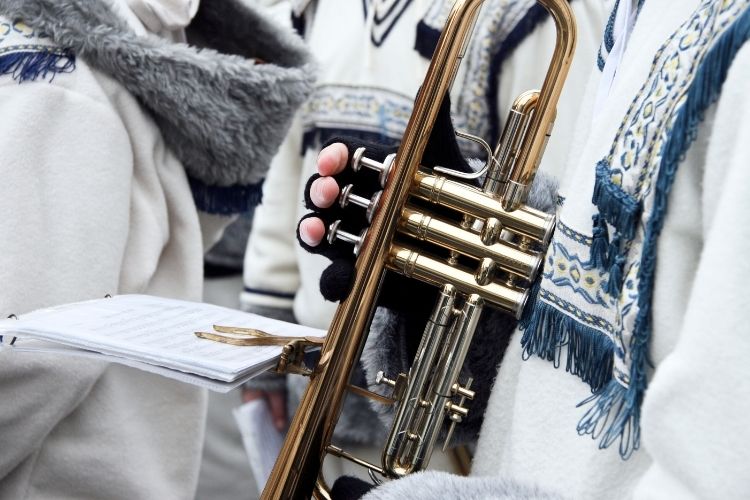
The structure and mechanics of the trumpet are based on the harmonic or overtone series. To understand it, we should start with tone attributes. A tone can be described by many physical characteristics such as frequency (the shorter the wavelength, and higher the frequency, the higher the note sounds), amplitude (loudness), or color.
Its frequencies define the tone’s color. If a tone has only one frequency, it sounds like a digital watch alarm of a whistle. Musical notes generally include more frequencies, so they are more colorful and provide a full sound. “…a very particular set of frequencies is heard. Each note that comes out of the instrument is actually a smooth mixture of many different pitches.
These different pitches are called harmonics, and they are blended so well that you do not hear them as separate notes.” (Earmaster, 2020) The notes of the harmonic series are a set of frequencies that are positive integer multiples of a common fundamental frequency, as can be seen on the below image:

(Offermans, 2012)
So, let’s translate physics into musical notes: if A is fundamental, its frequency is 440 Hz, and an octave above (as the second harmonic) will have 880 Hz. The third harmonic will be a fifth above (E) with 1320 Hz and so on. As earlier said: the higher the frequency, the higher the note sounds. The below image shows the harmonics of the low C.
(Offermans, 2012)
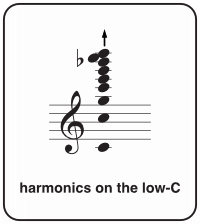
This harmonic series shows us which notes can be played on a natural trumpet from the 14th century (or with one fingering on a valved trumpet), while it also helps us see which note’s frequencies can be found in one musical note.
Both attributes are important from a trumpet learning aspect: we have to play full, rich notes (which means it contains more harmonics). Many trumpet exercises are designed for the harmonic series.
Trumpet Mechanics

One of the most frequently asked questions by laymen is: how can multiple notes be played with only three buttons of the trumpet? Of course, since we are now aware of the harmonic series, we can play at least nine notes with one fingering (pressing one button on the trumpet).
Okay, that’s more than three. But what about the other notes? And how do we use the trumpet’s buttons? So let’s dive deep into the mechanics of the trumpet and discover answers to our questions! A general trumpet has three buttons and valves, which allows us to have seven different combinations (however, the trombone has quite different mechanics.
It also has seven positions, which can be equivalent to the trumpet’s seven finger combinations). We mark trumpet buttons with numbers starting from the player’s perspective. That’s how we get button 1, button 2, and button 3.
The instrument has a central valve system, leading air to three additional slides (one slide per valve). The three slides have different lengths, and they can change the tone with half (button 2), one (button 1), or one and a half (button 3) pitches, and they can be combined. Let me list the combinations below:
So the low C on the chart is the second harmonic of the fundamental C, which cannot be found on the trumpet (can be produced as a pedal tone, but that cannot be treated as a normal note and requires advanced techniques). The harmonic series of the C can be played without pressing any buttons. It is marked with zero (0). A half note lower with button 2 we can play the harmonic series of low B and so on.
The length of their valves can determine the order of the buttons by building a chromatic (half-note step) scale. So coming down from C, let me show you the notes of the chromatic scale and fingerings:
- B: press button 2 (half note lower than C)
- Bb: press button 1 (one note lower)
- A: press button 1 + 2 or 3 (one and a half note lower)
- Ab: press button 2 + 3 (2 notes lower)
- G: press button 1+3 (2 and a half notes lower)
Since we can play the G with zero fingering as well, we can start the fingering combinations from the beginning to step down by half pitches:
- F#: press button 2 (half notes lower than G)
- F: press button 1 (one note lower)
- E: press button 1+2 or 3 (one and a half note lower)
- Eb: press button 2+3 (2 notes lower)
- D: press button 1+3 (2 and a half note lower)
- C#: press button 1+2+3 (3 notes lower)
So we are now able to play all notes. As mentioned earlier, if we play higher, due to the harmonic series, notes with the same fingerings are closer to each other, and that’s why we will have more opportunities to choose fingerings in the higher register.
Basic Exercises for Playing the Trumpet
Breathing
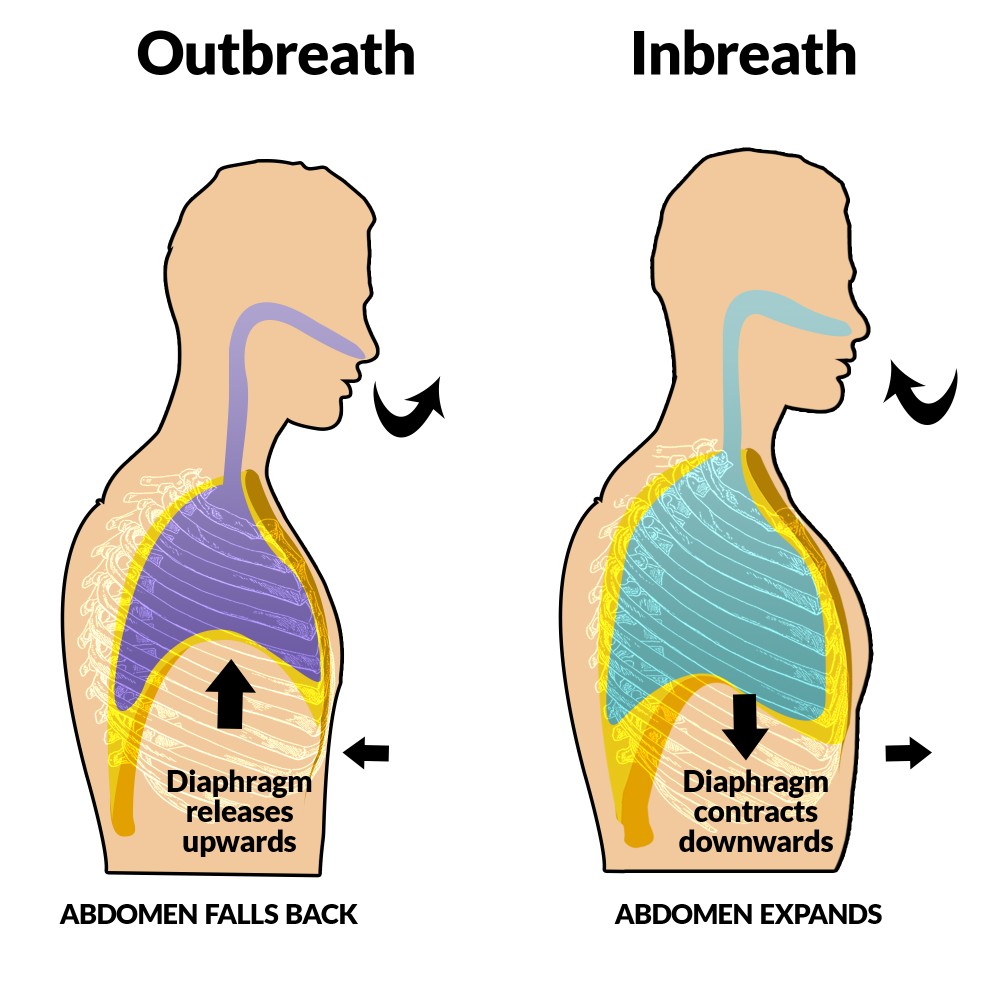
Since the airstream makes the sound by vibrating the lips, it is essential to acquire the proper breathing technique if we would like to play the trumpet. We generally call “the complex system of how to process air by playing” breathing, but we’ll see that the process has more steps than inhaling and exhaling. The use of air by trumpet playing works very similarly to bagpipes.
First, a bagpipe player blows up the bag through a blowstick, then starts to press out the air with his arms through its tubes, where the pressed air vibrates the reeds and therefore creates the sound. I use the bagpipes example because, in my opinion, the sections of the bagpipes operation process clearly describe the phases of how to use the airstream by playing the trumpet.
“Breathing in is accomplished by the raising and widening of the chest by means of the intercostal muscles and also by a vertical expansion of the chest cavity by means of the diaphragm, which before breathing reaches upwards in the shape of a dome, but during supporting and breathing in contracts in such a way, that it flattens out pushing the contents of the abdomen and the abdominal muscles down and forwards…
Breathing out takes place in reverse order, that is, by the relaxation of the costal cartilage, slightly distorted during raising, and by the return of the diaphragm to its starting position, which is supported by the contents of the abdomen and the abdominal muscles pushing back to their rest position.” (Rolf Quinque: Atmung, Stütze, Ansatz Method, BIM, 1980)
This detailed, scientific explanation of breathing is visualized on the below diagram. What is important for us is to know we have to train all these muscles (diaphragm, abdomen..) to be able to produce a compressed airstream.
Chest Breath or Belly Breath?

When we read about breathing, the two phrases ‘chest breath’ and ‘belly breath’ often pop up. So what do they mean? If we have a look at the image above, we can see that by the upper chest inhale, our shoulders move up and the chest out, while by belly breathing, the shoulders stay still, and our stomach moves outwards.
Generally speaking: by chest breathing, we feel that we inhale air to our lungs, while by belly breathing, we feel like all the air would stream to our stomach (even if it’s physically impossible). A woman’s physical structure makes chest breathing easier for them (makes breathing easier during pregnancy), while men generally use belly breathing.
If we look at popular breathing methods for wind players, we conclude that the ideal breathing technique is when we mix the chest and belly methods.
Famous Breathing Methods in a Nutshell
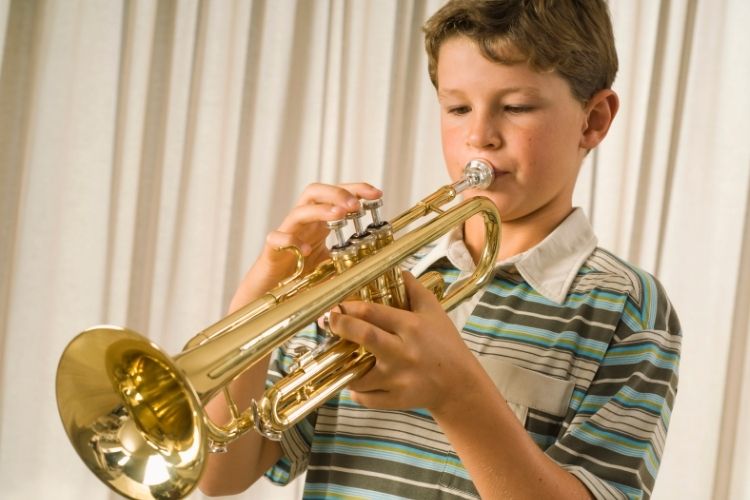
Rolf Quinque: Atmung, Stütze, Ansatz Method
The Quinque Method doesn’t provide new techniques. However, it offers a systematic practice to develop breathing. His program has three main points:
- Strengthening the abdominal muscles: Quinque prescribes a few situps, crunches, and leg raises on a daily basis
- Diaphragm breathing: provides four exercises to deploy diaphragm breathing instead of chest breathing by placing the hands on the stomach to feel the difference
- Generating diaphragm pressure: if the player lays down and puts a weight (for example, a trumpet case) on his stomach, he’ll be able to practice the continuous diaphragm support during breathing out
Super Lung Power & Breath Control in 5 Minutes a Day by A. A. Sandy Adam
The Sandy Adam method is one of the best-known and most easy-to-follow approaches for developing breathing. The method consists of sixteen different exercises, which are built up and varied for 21 days. The method doesn’t provide new techniques but easy exercises, which help to stimulate all muscles that take part in breathing.
Michel Ricquier
Michel Ricquier is a professional musician, teacher, studied at the Conservatoire of Paris, worked together with the legendary Maurice André, then turned to psychology and traditional Chinese medicines and an active yoga practitioner.
With his knowledge of various fields, he developed a method (Traité Méthodique de Pédagogie Instrumentale) from a psychological perspective of playing, which can help to handle stage fright, build mental health, and develop breathing as well.
The Ricquier method is more complex than the Adams. It provides exercises for the full body, strengthens muscles for belly breathing, and upper chest breathing as well.
Wedge Breath
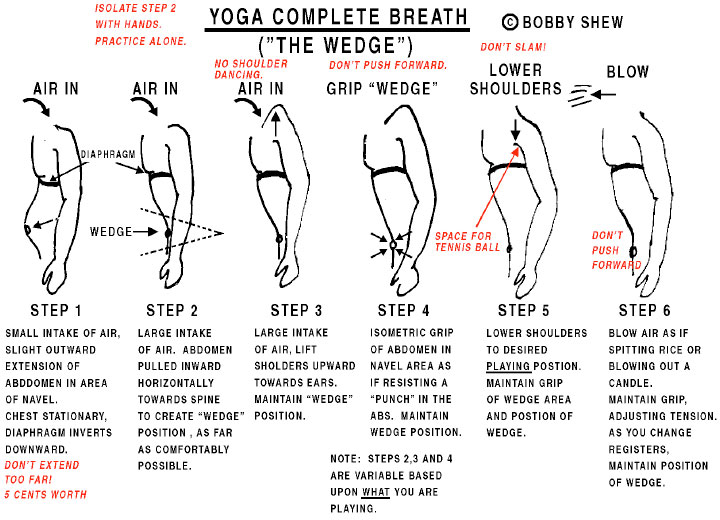
The Wedge Breath method (or often called as is a complex, new way of breathing. The former methods are generally just a collection of exercises, which can be practiced alone, without a teacher. The learning of wedge breath requires the supervision of a mentor.
It is often treated as a holy grail of breathing for brass players. Many trumpet masters have used and continue to use this method, such as Bud Brisbois, Maynard Ferguson, Bobby Shew, Eric Miyashiro, Wayne Bergeron, Roger Ingram, etc.
Rumors say that Maynard Ferguson first used this technique. While he shared the book ‘The Science of Breath by Yogi Ramacharaka with Bobby Shew, he didn’t explain it to Bobby and it didn’t work. Bobby Shew later met Bud Brisbois, who used the same breathing method and was kind enough to explain the technique in detail for Bobby.
Bobby then created his own detailed version of the Yoga Breath, called the Wedge Breath, and teaches it to many of his students since then.
Later it turned out that “Yogi Ramacharaka was actually one of many pseudonyms used by William Walker Atkinson, a Chicago-based writer and leading figure in the New Thought movement of the early 20th century–not a real yogi, but a serious student of eastern ideas.” (Bob Jacobson, 2016)
Let me share Bobby Shew’s simplified graphics of the Wedge Breath:
Breathing Exercise While Walking
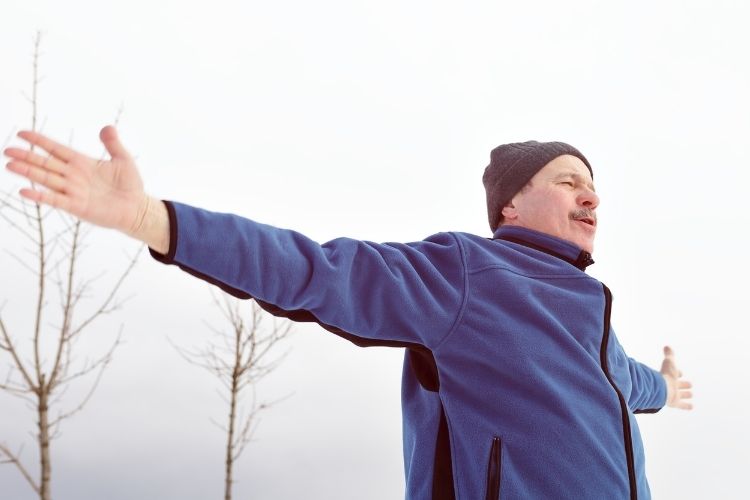
We are now aware of how to breathe correctly, so let me recommend an easy exercise, which doesn’t require specific poses or a calm place. You can invisibly practice it while you are walking. At the base of the exercise, that you will develop the interval, you can hold your breath by counting your steps.
You should walk at a normal tempo with the same speed during this exercise. For example, while you step four, breath in, then hold your breath for four steps, then breath out for another four steps and hold it (the lack of air) for another four steps.
This is one cycle, which you can increase step-by-step to five, six, seven, eight until it is possible. When you feel you reached your maximum, start to breathe normally for a few steps or half a minute, then start it from the beginning. This easy exercise can be done anywhere, on the streets, in your workplace, in the school, and has a lot of positive effects.
Buzzing
As a first step, we learned how to breathe correctly, so let’s take another step and start to produce sound with our super airstream!
Buzzing is the activity of tensing our lip corners and pressing out air through the middle of the mouth. So it’s the way of pretending to play on the trumpet without the instrument itself. The effects of buzzing are argued among trumpet players.
Some never use it, some do it only for 1-2 minutes as the start of a warm-up, while others do complex exercises only with free buzzing.
Supporters of buzzing say that it strengthens the facial muscles without pressing the trumpet to the mouth, so we can be sure to avoid injuries. Others say that buzzing uses muscles differently than trumpet playing, and therefore, it has more disadvantages than benefits.
Eric Miyashiro says he buzzes for a few minutes just to wake his facial muscles up but doesn’t practice anything with buzzing.
Mouthpiece Buzzing

Just like free buzzing, mouthpiece buzzing is treated differently by many players. Some use it as a part of everyday warmups. Some use it by learning new pieces, while others use mouthpiece buzzing exercises to heal or to let bad habits go. So let me sum up some pros and cons.
Eric Miyashiro says he doesn’t use mouthpiece buzzing for warmups, but only for practicing sometimes because warmup is for finding our best sound and feel, and a mouthpiece is not suitable for that. However, many players use the mouthpiece to practice hard parts in pieces because it is more effortless to play it with a mouthpiece, and we can use muscle memory to make it easier to play with the trumpet as well.
A popular tool for practicing with a mouthpiece is the B.E.R.P. (Buzz Extension Resistance Piece). As it can be seen in the below image, it can be attached to the trumpet’s leadpipe, so we can hold our trumpet as we usually do by playing, and we can even use the buttons by practicing, but the whole process is more effortless.
As I mentioned, some use the trumpet for healing or more effective playing, and the James Thompson method is just perfect for that.
The aim of this method is to lead the notes only with the airstream, and therefore the Thompson practice book uses many glissandos (which normally don’t work on the trumpet). So this method can be used temporarily if players would like to go back to the effective way of playing.
Leadpipe Buzzing
Leadpipe buzzing is used for the term when we pull out the tuning slide from the trumpet, but insert the mouthpiece into the leadpipe and play on the mouthpiece inserted into the leadpipe. The leadpipe buzzing tries to avoid the cons of the mouthpiece or free buzzing since the longer tube allows a nicer sound, more close to the trumpet.
The disadvantage of the leadpipe buzzing is that due to its longer size, harmonics appear by playing it, and therefore, free glissandos are not so easy to play.
General Trumpet Exercises
We learned how to breathe, how to buzz, so we are ready to actually play the trumpet. Let’s go through some basic exercises, which are essential for every trumpet player.
Arban
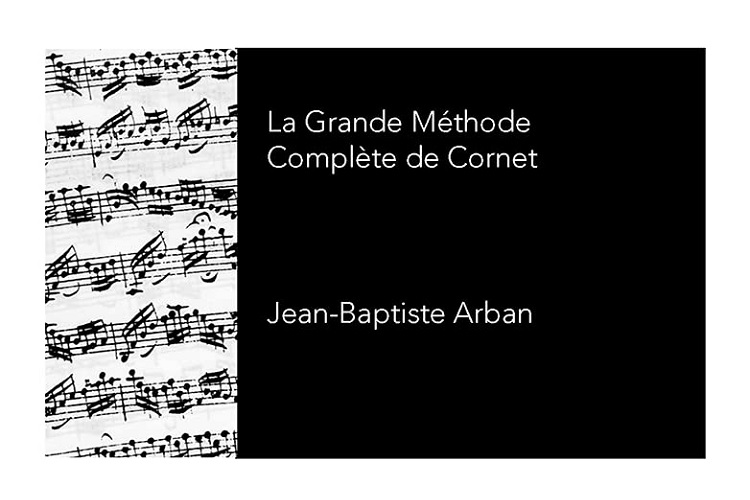
Jean-Baptiste Arban’s La grande méthode complète de cornet à piston et de saxhorn is the most important trumpet method book for trumpet players. It is often called the Bible of trumpeters. However, it is used by the tenor horn, euphonium, trombone players as well.
This method is an excellent collection of all types of exercises that a trumpet player would need. However, there are many great methods, which include extended exercises, which better suit today’s modern trumpet players’ needs.
The more than 150 years old method is still accurate, and many professional players learned from it and use this exercises daily. We often can hear Maestro Arturo Sandoval, Allen Vizzutti, and many great players talking about their daily Arban routines.
So let’s go through those basic exercise types, which are covered in the Arban book.
Rule of thumb: when we practice, we have to examine ourselves from two aspects: physical and musical. Since our body is generally not created to play the trumpet, we have to train our muscles to be able to adapt to the hard work that trumpet playing requires.
Our muscles (facial muscles, mouth/embouchure, tongue, fingers, muscles for breathing) always have to be trained but relaxed and flexible. However, this physical approach is the basis of our playing. The final aim is always to be musical.
Great players say that we have to put music into every note, even if it’s just the first long tone of our morning warm-up.
Long Tones
Many trumpet methods start with long tones. They are important for beginners as well because by a long tone there is time for finding the note and trying to play it as nice as it is possible.
Long tones allow us to get used to relaxed playing and playing in a nice tone. Long tones also help to develop endurance and, therefore, to deploy high register playing.
Scales
Scales and scale variations are essential exercises as well. After long tones, we can continue with small parts of scales (first 3-4-5 notes). There are many scale books for different needs.
Scale exercises for classical players usually consist of major and minor scales, and as a part of their variation, some modal scales and chromatic scales also. Scales can be practiced with triad and fourth steps as well. Scales are recommended to be practiced slurred, legato and staccato as well.
The advantage of scales is to learn to play in different keys and to develop muscles and the synchronization of tongue and fingers, which are all essential elements of trumpet playing.
Intervals
Start to practice intervals very softly, slurred, and with small steps (for example, triads).
Due to the physics of the trumpet, we can easily practice intervals with the tones of the harmonic series, which allows us to play interval exercises with one fingering. This allows us to only concentrate on our airstream.
The aim of these exercises is to lead the notes only with our air and possibly with minimum embouchure movements. If we can easily play the chosen intervals slurred, we should practice it tenuto and staccato as well.
We should start interval exercises very slow and then practice them faster step by step. If we are done with that, we can step to the next note of the harmonic series (for example, we start with C to E – triads and continue with C to G – fifths).
A good set of interval exercises can be found at Bryan Davis’ tutorial below:
Double Tonguing, Triple Tonguing

There are special tonguing techniques called double or triple tonguing. The point of this technique is to be able to play tongued (staccato, tenuto) parts faster than with a normal (single) tonguing technique.
By normal tonguing, we use the tip of the tongue, while by double and triple tonguing, the back part of our tongue is being used as well. For the tip of the tongue, we use the ‘ta,’ ‘da’ syllables, while by the back of the tongue we articulate ‘ka’ or ‘ga.’
By double tonguing, you mix the two syllables similar to when you say the word ‘ticket.’ Let me include some basic double tonguing exercises below:
FAQs
Answer: Well, that’s a complex question! The mechanics of the trumpet is based on the harmonic series. The harmonic series is a set of frequencies that are positive integer multiples of a common fundamental frequency.
These integers are the notes, which follow them in the following steps: octave, fifth, fourth, triad…and so on. As a trumpet player blowing his instrument, he presses his lips in the corners and makes them resonant with his airstream.
That’s how frequencies are generated and blew into the trumpet, so if the player doesn’t press a single button, he is able to play all notes of the harmonic series. The three valves of the trumpet let or close the air to three different slides with three different lengths.
With the mixed-use of the three buttons, he is able to set seven different slide lengths, and the seven half-note steps are able to cover the differences between the fifth of the harmonic series.
Answer: Yes, it is recommended to play the trumpet with a lot of air, but that doesn’t mean you have to blow it hard all the time. A lot of air is rather needed for compressing the airstream, which can better resonate the lips and therefore provide a nice, full sound.
For softer parts, you don’t have to inhale a lot of air, but compression is still very important.
Answer: It is recommended to wait until the front primary teeth are changed by the permanent teeth. However, every trumpet player is trying to use minimal pressure on the teeth, it can never be no pressure, and therefore front teeth are essential for playing the trumpet.
Answer: It depends. There are many types of trumpets on a wide range of prices. It’s similar to when you would like to buy a car. There are Rolls Royces of the trumpets, there are cheap copies of them, and there are used ones as well.
Most big companies provide instruments on a wide professional scale, from student models to professional ones.
Answer: The mouthpiece is a small (10cm long) asset, which – however not part of the trumpet – is essential for its use. Trumpet players actually buzz into the mouthpiece, which transfers free buzzing to a nicer tone, and then the trumpet will strengthen it.
There are many different sizes and types of trumpet mouthpieces for different mouth sizes, shapes, and for different musical genres.
Answer: There are many different types of trumpets. However, the most common one is the so-called Bb trumpet. There are smaller sizes of trumpets, for example, the piccolo and the pocket trumpet. A fun fact is that a pocket trumpet actually has the same tube length.
However, it is bent more than the normal one, and that’s why it looks smaller. On the other hand, the piccolo trumpet has a shorter tube, and that’s why it can play an octave higher.
Answer: Trumpets are made from various types of materials, but most of them are made of raw brass or goldmessing.
Some of them are silver or gold polished, while others are lacquered. Some trumpets are made of plastic, and however their sound is not as artistic as brass trumpets, they are very cheap and easy to repair.
